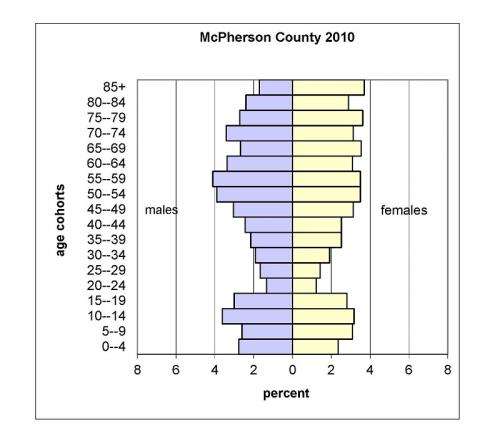Population projections show strain in counties keeping quality of life

Traditionally, age demographics in each of South Dakota's 66 counties would resemble a pyramid: wide at the bottom for people in their younger years and narrow at the top for the older population.
The traditional pyramid is what Michael McCurry, South Dakota state demographer, sees in some counties. However, following an eight-month study developing population projections through 2035, the results show a trend for population pyramids that are larger at the top than at the bottom.
"Much of our state is getting older," said McCurry, an assistant professor of sociology and rural studies and director of the Rural Life and Census Data Center at South Dakota State University. "Because of the continued out-migration of young people, in many rural James River communities the largest component of the population is now the elderly. This shows up clearly in the counties' population pyramids, which are a way of showing age distribution in a community and it gets more extreme as we project trends into the future."
McCurry's investigation is based on the following trends:
- Counties are losing population due to out-migration and death.
- Counties with good jobs are gaining in population.
- Counties are getting older.
- Birth rates remain low.
- Life expectancies are increasing.
- Medical progress continues.
- The in-migration driver is Sioux Falls with new residents moving to the state's largest city.
- The baby boom cohort is moving into retirement age.
McCurry uses the term "dependency ratio" in explaining his work, which was funded through the governor's office to show migration and aging trends across the state.
The dependency ratio is an age-population ratio of those typically not in the labor force (14-and-under and 65-and-over) and those typically in the labor force. The ratio is used to measure the pressure on a productive population. The higher the ratio, the more people there are who depend on others for care.
Defining the healthiest dependency ratio, and the best shape for a population pyramid, is a difficult task, according to McCurry, who indicates that population age distribution will change as the population gets older and what is healthy in one generation may not be healthy in the next. However, he said there are some general guidelines to support his study.
"A dependency ratio of around 50, where there are two working people for every dependent, is a fairly balanced population," he said. "A dependency ratio of 100, in which there is only one working-age person for each dependent, is a community under strain."
Looking at the numbers, McPherson County had the highest dependency ratio of 90.18 in 2010, but that number is projected to rise to 113 in 2035. South Dakota's dependency ratio was 54.06 in 2010 and is projected to be 73.35 in 2035, which is about what Faulk County is today.
"We don't have any inverted pyramids or dependency ratios over 100, but as they arrive, the strain will increase," said McCurry, who pointed out that the trend in South Dakota is to age in place.
"Our young people know that they can go anywhere in the country for employment and they do," he said. "An intriguing statistic is that a high school dropout is almost five times as likely to remain in rural America than a college graduate is to return to rural America.
"The youngsters leave for college and return only to visit, moving to metro centers like Sioux Falls or other metropolitan areas in the country."
McPherson County, noted McCurry, is a good indicator of what some counties might be facing. "In McPherson, we see the future – population pyramids that are top-heavy, showing an increased population of people age 85 and over. Never before has a society had to take care of such a large dependent population."
McCurry emphasized that his study isn't a prediction, but a projection of what will happen if things go on as they are.
"It's that hypothetical average South Dakotan who will find a way to deal with the approaching problem," he said. "In some communities, my hope is that they will attract new, young families to replace those who found that you can go anywhere from here."
According to McCurry, the average South Dakotan in the state is going to be looking at a society where 1 out of 20 South Dakotans will be over 85 and nearly a quarter over 65. In the extreme, a third of the population will be over 65.
"It's the last demographic twist of the baby boomers—the first boomer turned 65 last year and the first boomer turns 85 in 2031. From grade schools on, the boomers have changed our social structure, and as they move past active elder status, they will make one more change: needing dependent care."














